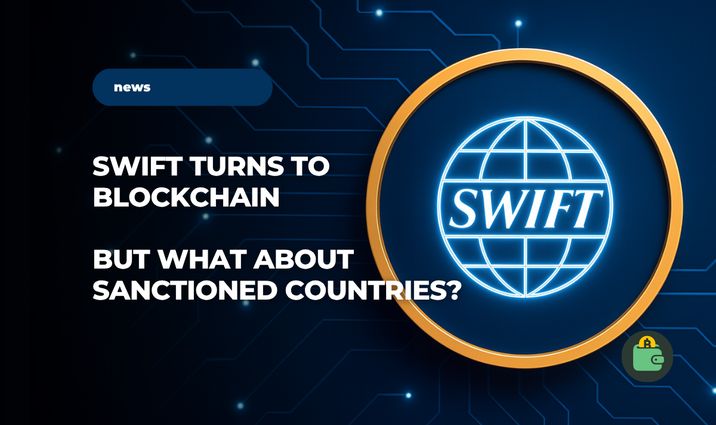SWIFT Integrates a Blockchain Prototype: What Does It Mean for Sanctioned Countries?

If you’ve ever waited days for an international fiat transfer, this great news is for you.
SWIFT (Society for Worldwide Interbank Financial Telecommunication) has announced a big move toward the future — it’s adopting blockchain technology. Together with ConsenSys, the company behind Ethereum, SWIFT is building a prototype platform that could make international money transfers instant, transparent, and available 24/7.
Let’s break down how SWIFT works today, what its blockchain plans mean, how this will affect regular users, and what happens with countries currently cut off from the system.
Key Takeaways
-
SWIFT is teaming up with ConsenSys — the company behind Ethereum — to build a blockchain-based prototype for faster, more transparent cross-border payments.
-
For users and businesses, this means faster international transfers, 24/7 availability, lower fees, and better transparency in tracking payments.
-
However, sanctioned countries won’t regain access to SWIFT just because of the blockchain upgrade.
How SWIFT Works Today
SWIFT isn’t a bank or a payment processor. It’s a global network that lets banks exchange secure payment messages.
When you send money abroad, your bank doesn’t physically move funds — it sends a SWIFT message to the receiving bank (or through intermediaries) with instructions on who should get how much.
Some quick facts:
- Over 11,000 financial institutions in 200+ countries use SWIFT.
- Around $7.5 trillion worth of transactions are sent through SWIFT messages every day.
- It’s the standard for secure international transfers.
The downside? The system is slow and fragmented. Payments often pass through several correspondent banks and can take anywhere from a few hours to several days. SWIFT has been improving things with its gpi system (for tracking payments), but it’s still far from true instant transfers.
What SWIFT and ConsenSys Are Building
Now SWIFT is turning to blockchain to make global transfers faster and more efficient.
In September 2025, SWIFT announced it’s developing a shared digital ledger — basically, a blockchain for banks that will record every transaction securely and in real time.
To make this possible, SWIFT is working with ConsenSys, the Ethereum development company founded by Joseph Lubin. Together they’re testing Ethereum Layer 2 Linea, a fast, scalable blockchain platform that can handle thousands of transactions per second with very low fees.
In simple terms:
- Banks will be able to exchange not just messages but digital tokens that represent real money.
- Every transaction will be stored in a shared, tamper-proof ledger.
- Smart contracts will automatically check and process payments according to set rules — no manual work needed.
More than 30 major global banks are already involved — including Bank of America, Citi, Deutsche Bank, JPMorgan, HSBC, and Santander. This isn’t just an experiment; it’s a joint effort to rebuild cross-border payments for the digital era.
What It Means for Users
With blockchain technology, payments could become instant and available around the clock, regardless of weekends, holidays, or time zones. What used to take a day could soon take minutes — or even seconds.
Key benefits:
⚡️ Speed. 24/7 real-time transactions without intermediaries.
💰 Lower costs. Fewer middlemen mean fewer fees.
🔍 Transparency. Banks (and possibly users) can track payment status instantly.
🧠 Automation. Smart contracts reduce errors and delays.
🌍 Innovation. Easier integration with CBDCs, stablecoins, and tokenized deposits.
SWIFT also promises that its blockchain system will keep all the things banks rely on it for — security, reliability, and compliance with regulations.
In other words, this isn’t about turning SWIFT into a “crypto network.” It’s about upgrading the old system with new tech without losing trust or oversight.
Why This Matters
For years, blockchain was seen as a competitor to SWIFT — even a threat. Projects like RippleNet and Stellar aimed to replace traditional banks with decentralized systems.
Now we’re seeing the opposite: major financial players are adopting blockchain themselves. SWIFT isn’t fighting innovation — it’s embracing it.
This marks a shift from competition to collaboration.
If even part of SWIFT’s daily traffic moves to blockchain, it could dwarf the current transaction volume on public networks like Ethereum — pushing blockchain scalability to new limits.
In short, SWIFT is building a bridge between traditional finance and decentralized technology.
What About Sanctioned Countries?
A common question is: if SWIFT moves to blockchain, will countries that are currently cut off — like Russia or Iran — be able to rejoin?
The answer is no.
Changing the technology doesn’t change the rules. SWIFT is a Belgium-based cooperative that follows the laws of the EU, the G10, and international regulators. If a bank is under sanctions, it cannot participate, even in a blockchain version of SWIFT.
According to official SWIFT statements, the organization does not decide on its own whom to disconnect — it simply implements the decisions of governments and regulators.
And since the new blockchain ledger will be closed and permissioned, only verified, compliant banks will have access. This isn’t an open crypto network anyone can join.
So for sanctioned countries, nothing changes — as long as restrictions remain in place, access to SWIFT stays off-limits.
The Bigger Picture
SWIFT’s move toward blockchain isn’t just a tech update — it’s a sign of a new financial era.
- Global finance is learning to speak the language of blockchain.
- Traditional banks are embracing decentralized tools — without losing control.
- And users might finally experience cross-border payments that are as fast as sending a message.
Right now, it’s still a prototype, and testing will take time. But with more than 30 major banks on board, it’s clear this is not a short-term experiment — it’s a strategic direction.
SWIFT isn’t turning into a crypto company. It’s turning blockchain into part of the global financial infrastructure. And if this succeeds, sending money abroad might soon feel as quick and easy as sending an email.